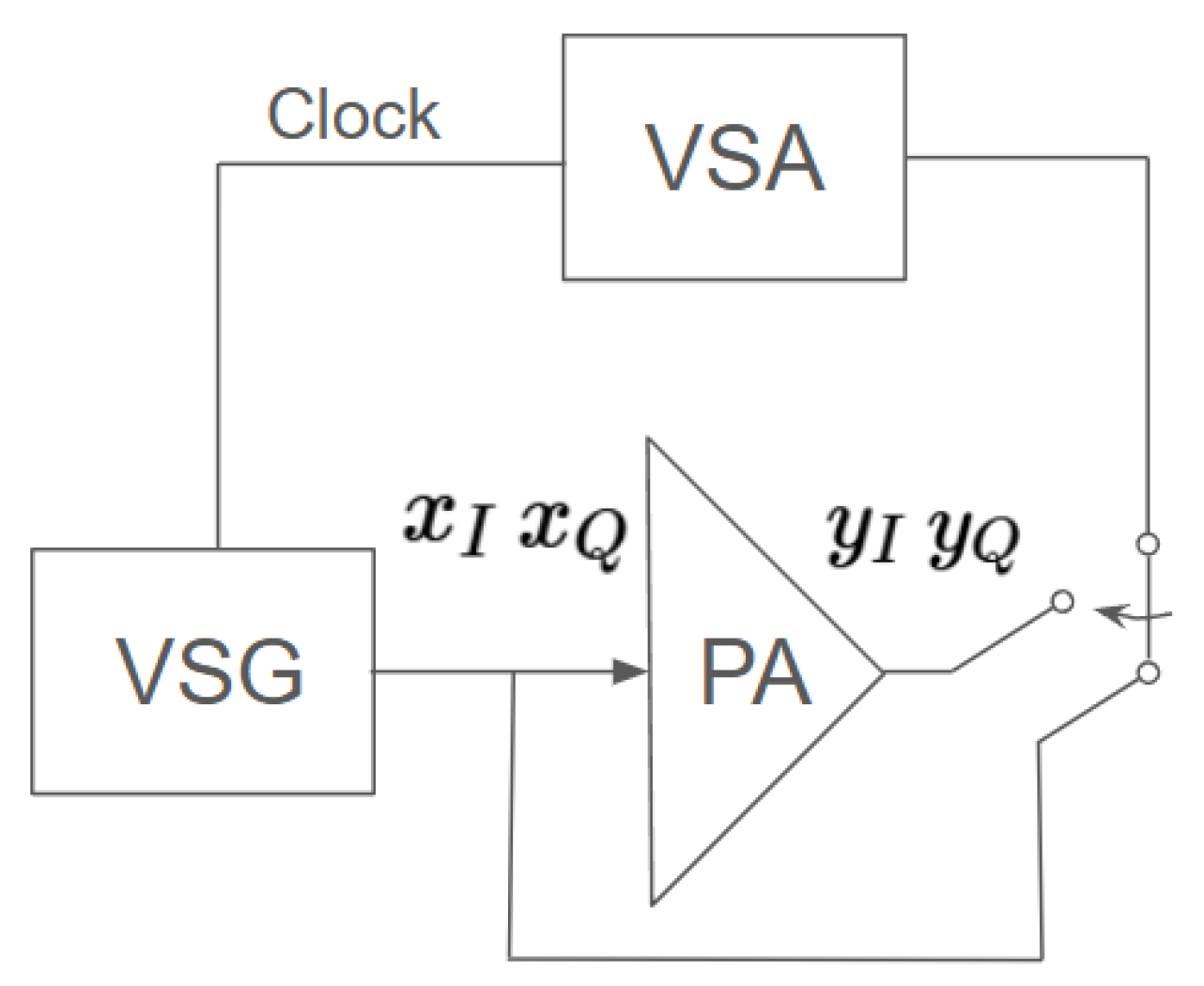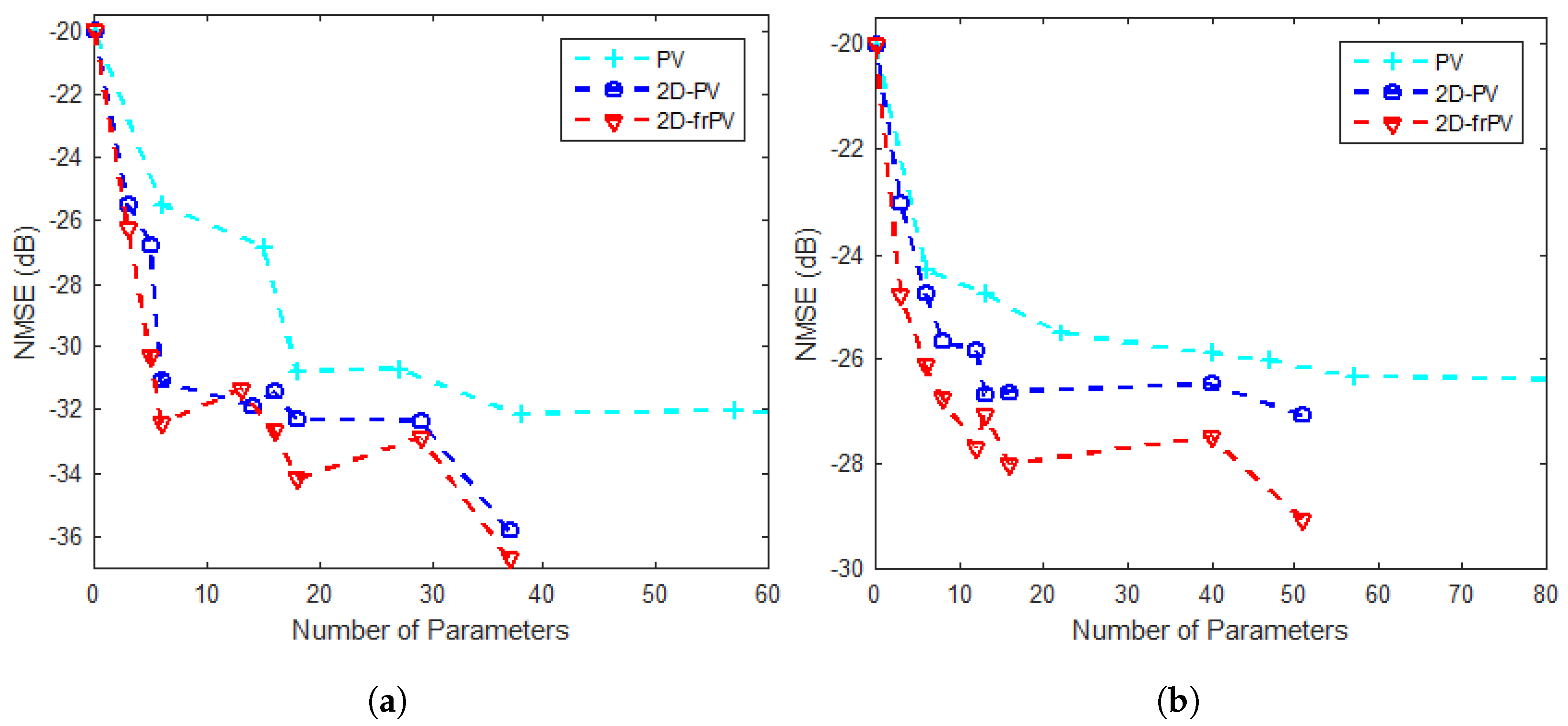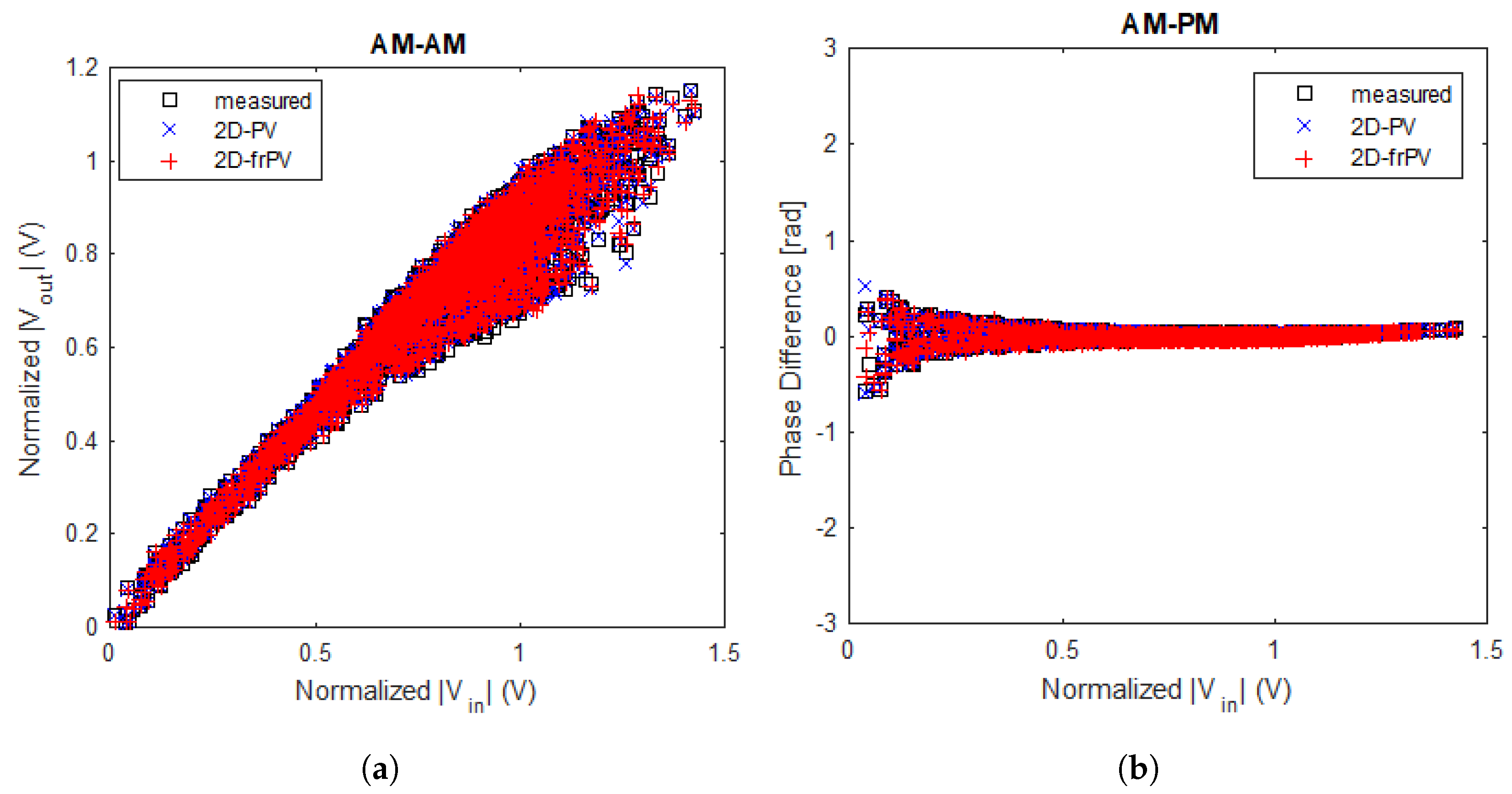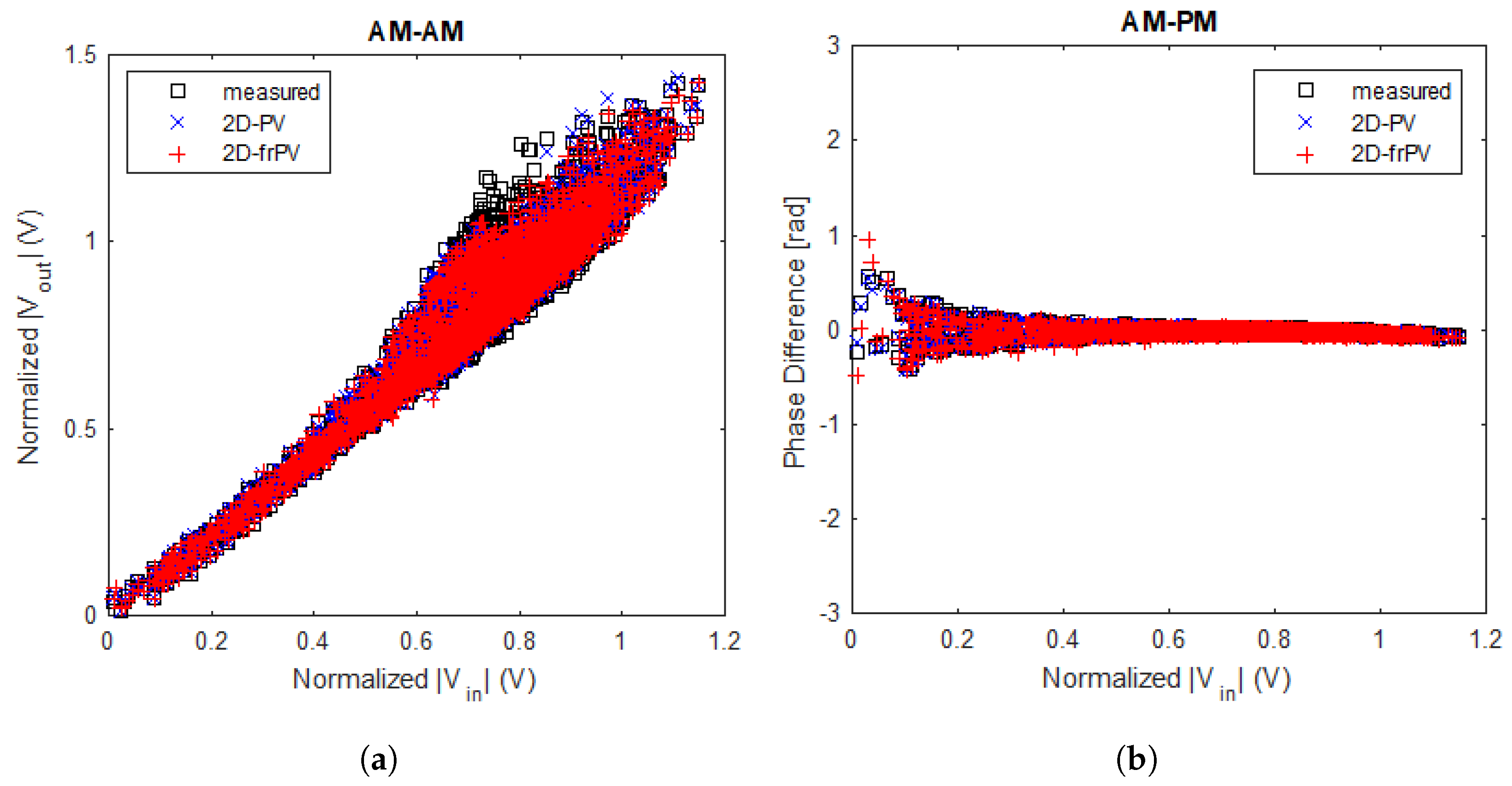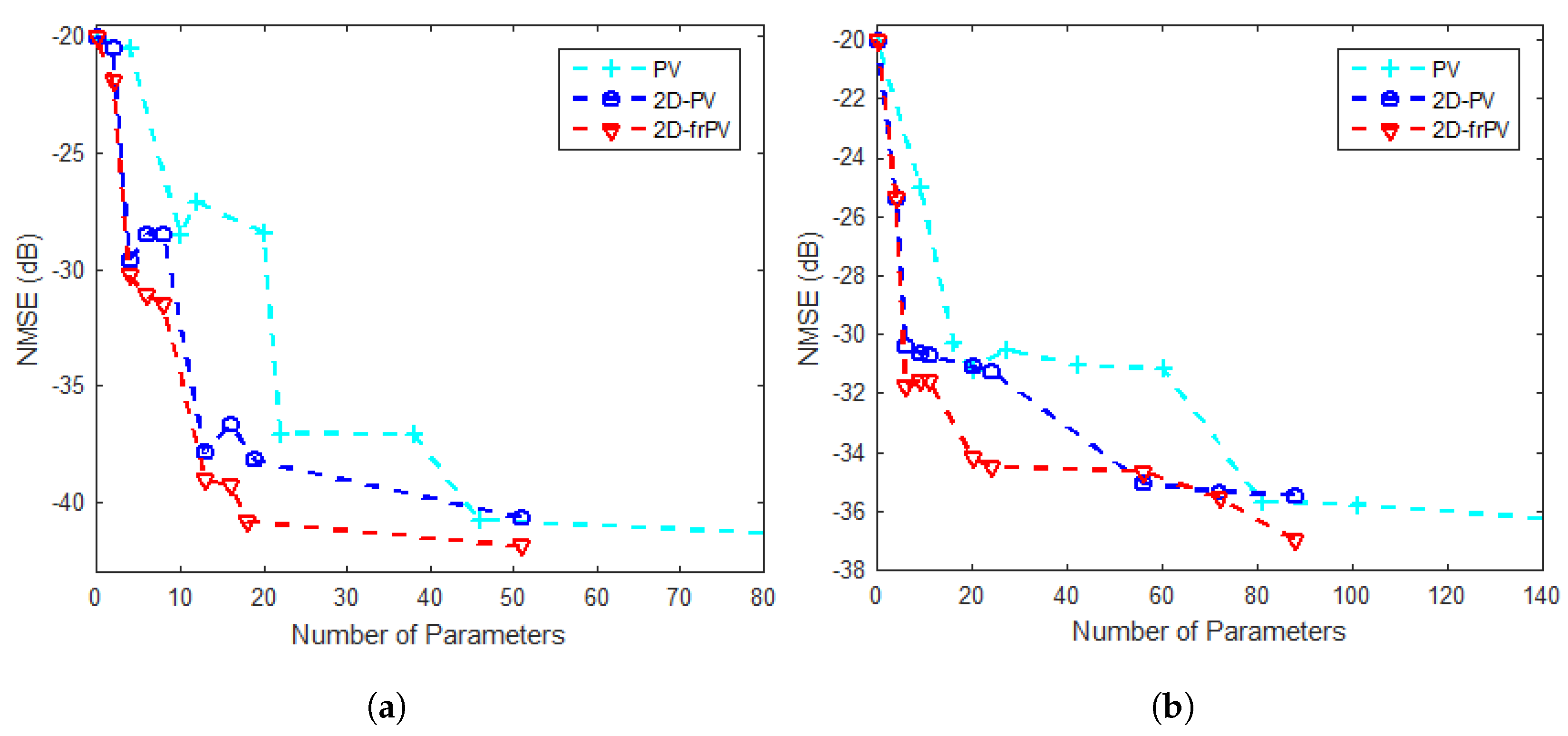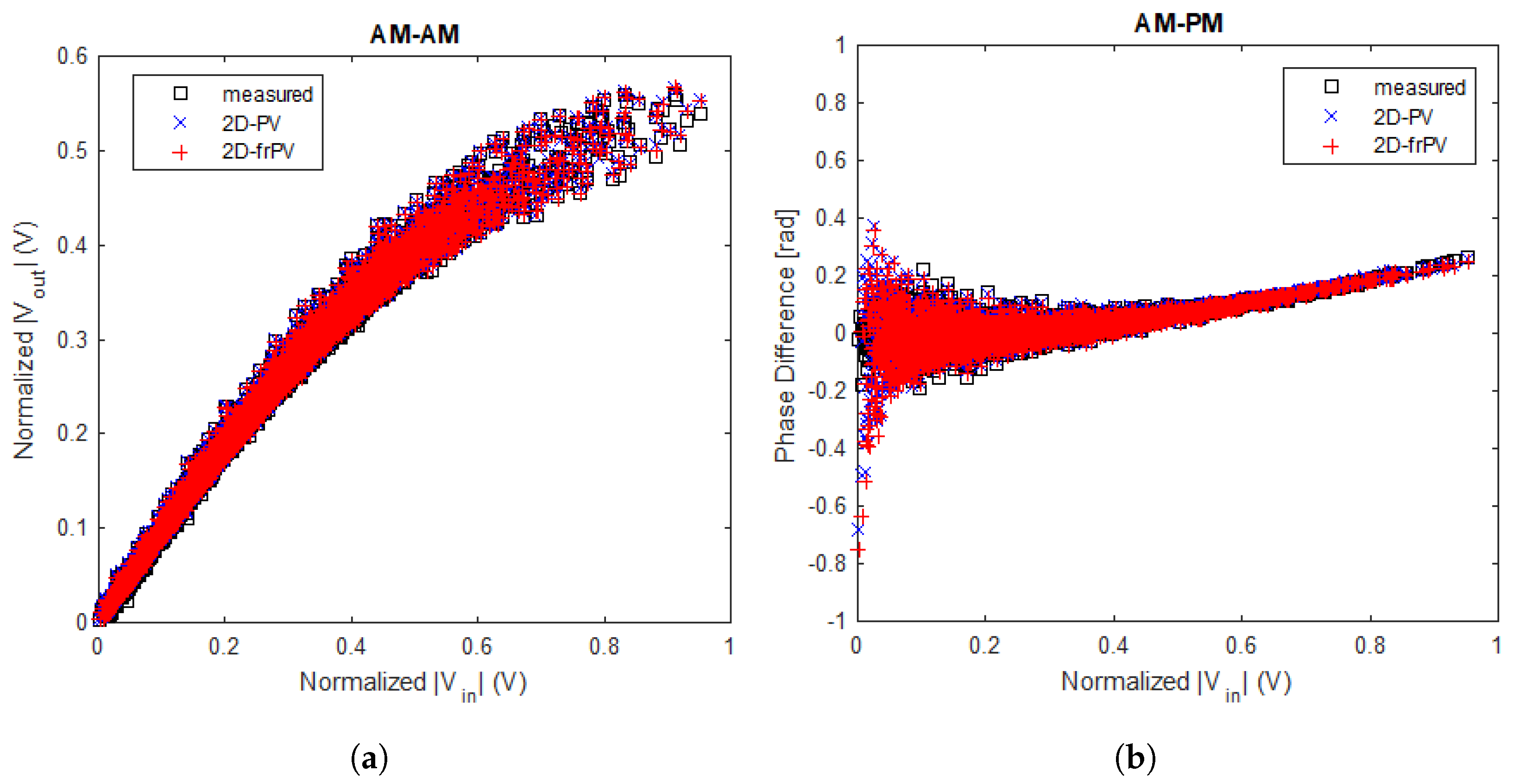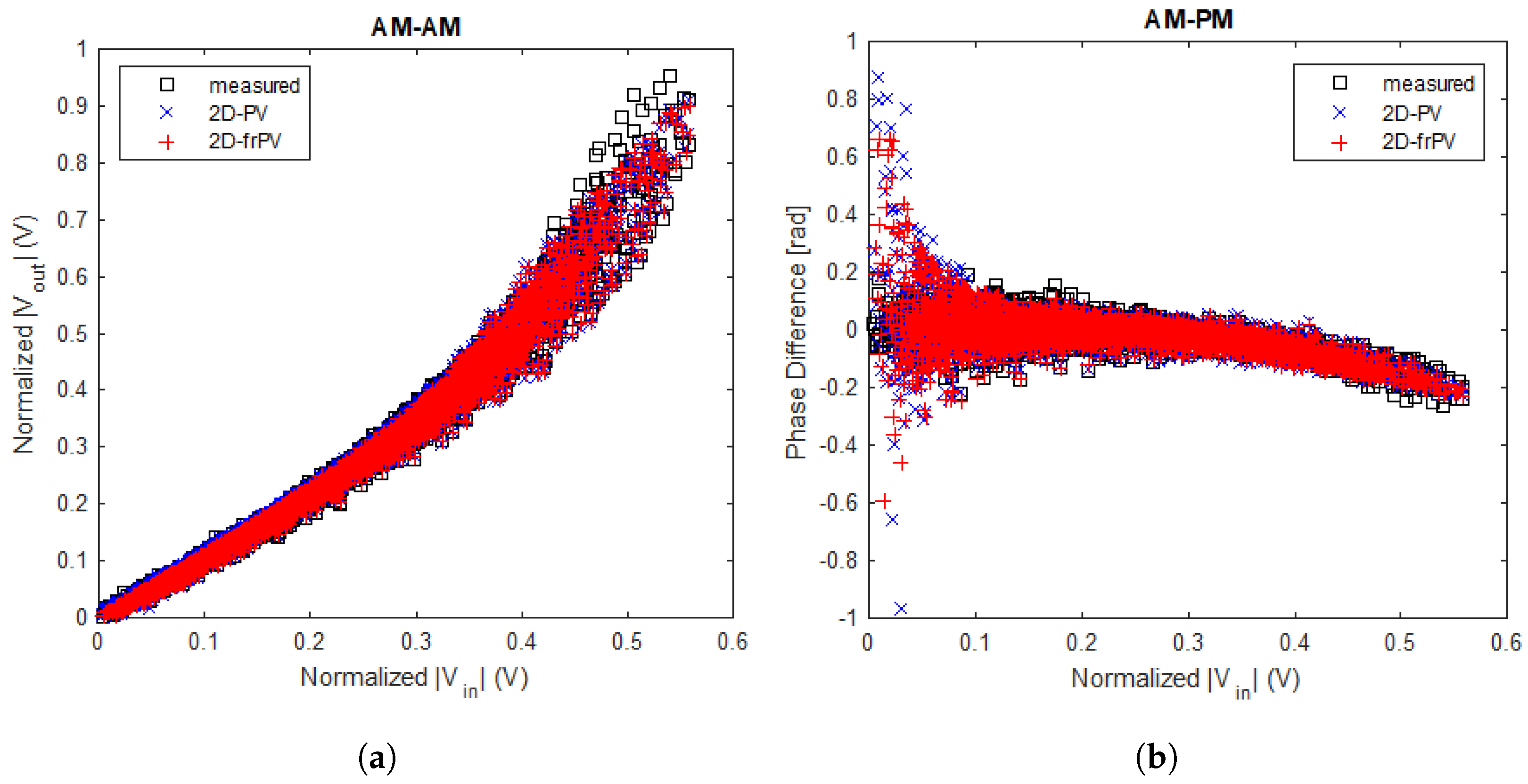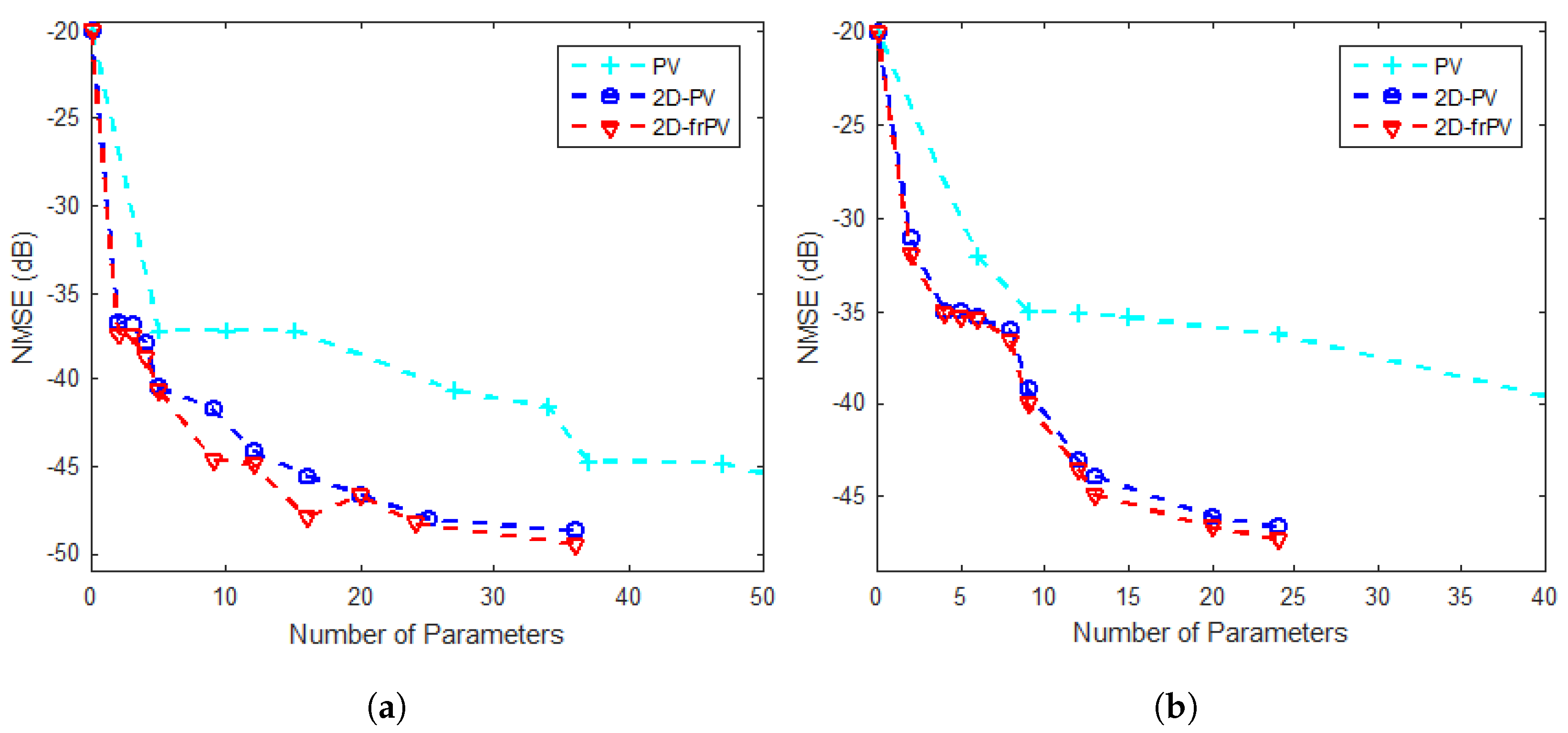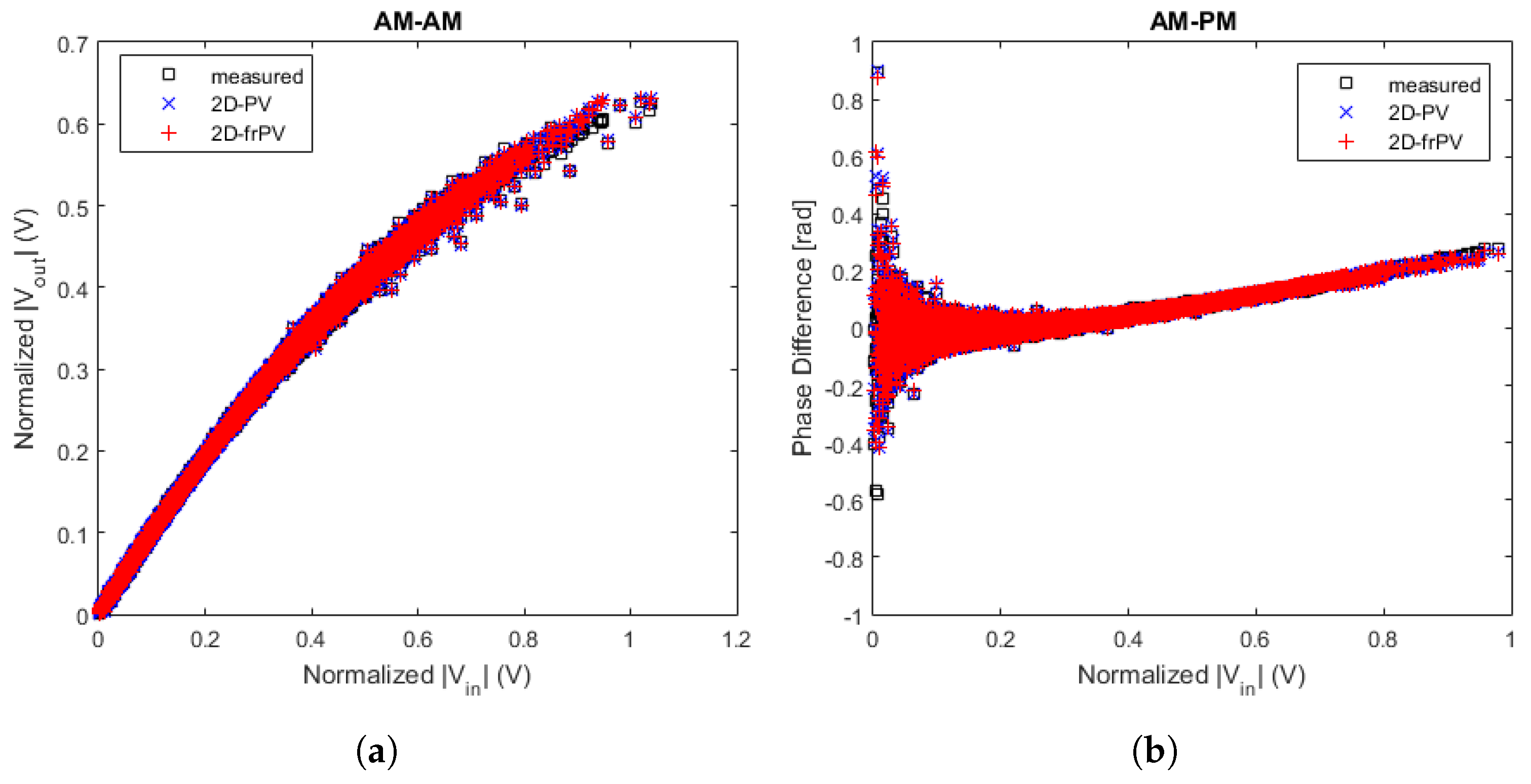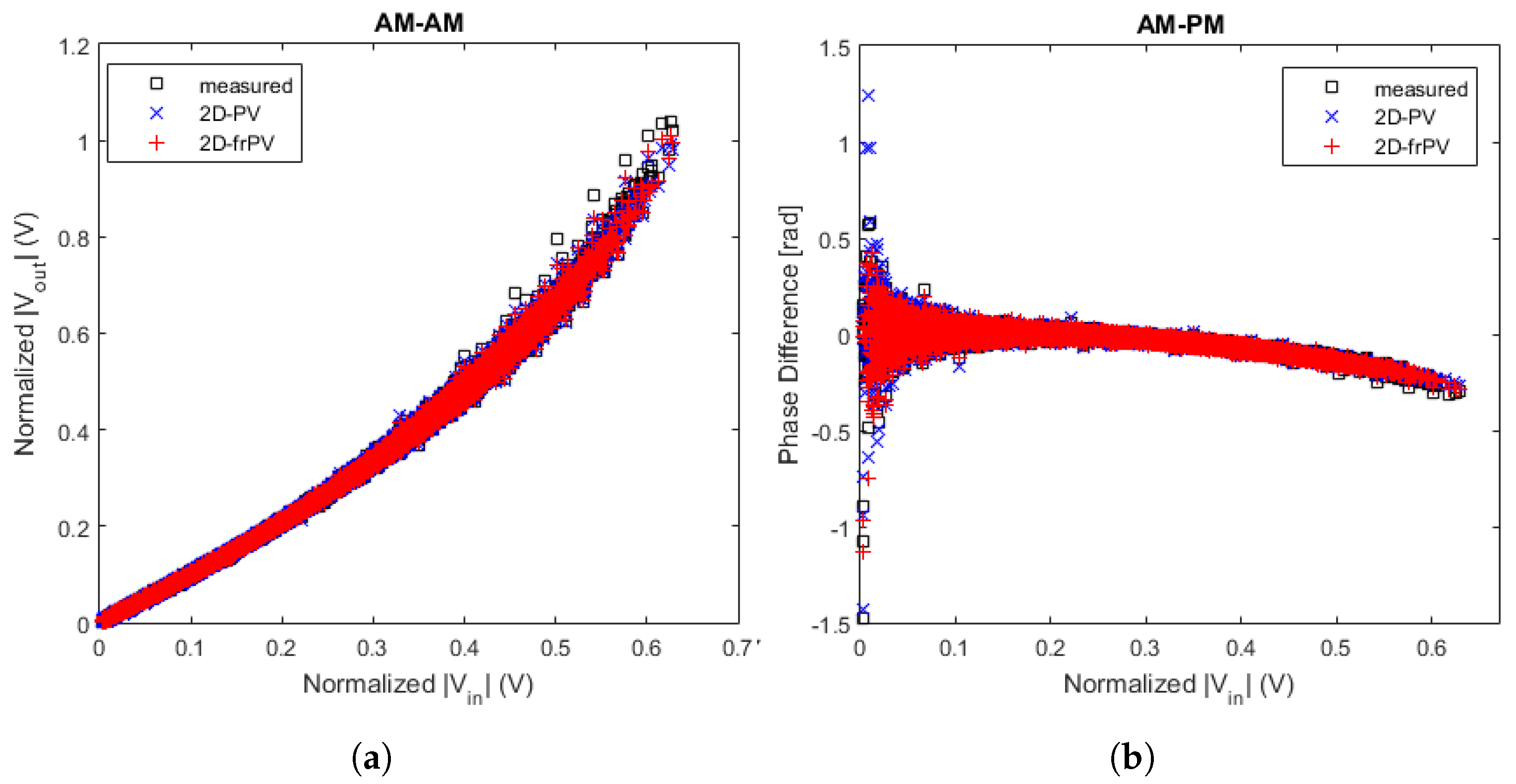2.2. Two-Dimensional Polar Volterra Series
The discrete-time Polar Volterra series (
) [
15] is given by:
where
are complex coefficients,
and
represent, respectively, the amplitude and phase components of the input complex-valued envelope signal
,
is the amplitude polynomial truncation order,
M is the amplitude memory duration,
is the phase polynomial truncation order and
L is the phase memory duration.
The number of generated coefficients in the
model of Equation (
6) is strongly conditioned by the four truncation factors
,
M,
and
L. However, the number of coefficients increases very rapidly with increasing values of these truncation factors
,
,
M, and
L. An increase in RF PA coefficients has a direct effect on increasing the computational complexity of a Polar Volterra model, which does not allow for a compromise between the accuracy and the computational effort. On the other hand, regardless of the values of the polynomial and memory truncation factors, greater accuracy in the
model means a higher amount of generated parameters. The consequence of this is that it becomes a challenge to achieve an RF PA operating at its highest energy efficiency. However, a hardware DPD implementation based on the RF PA characteristic will have a high energy consumption that can be even higher depending on the number of multiplications among
and
where
,
and
where
,
and
where
, products of the amplitudes, products of the positive phases and products of the negative phases, all required in the
model. Therefore, this makes the power consumption of the RF PA and DPD acting together greater than the power consumption of the RF PA acting alone. Some researchers have proposed strategies to reduce the number of generated parameters in the
model of Equation (
6) without, however, reducing its accuracy in any way and without compromising the computational effort performed in the low-pass equivalent behavioral modeling of an RF PA [
12,
13,
14]. Some of these strategies include simplifying the
model to decrease the influence of past time instants. This simplification technique of the Volterra series with polar terms considers only one-dimensional and two-dimensional terms. Thus, considering only the one-dimensional and two-dimensional terms as in [
14], Equation (
6) can be rewritten, in general, as the two-dimensional Polar Volterra model, (
):
where
is the amplitude polynomial truncation order,
M is the amplitude memory duration,
is the phase polynomial truncation order and
L is the phase memory duration. In this
model, the one-dimensional terms are related to the contributions of the amplitude and phase input signals at a single time sample, where the products are performed when the amplitude and phase memory delays are
, independently of the amplitude and phase polynomial truncation orders. two-dimensional terms are related to the contributions of the amplitude and phase input signals at two different time samples, consecutive or not, if the products are performed through two distinct memory delays. Three-dimensional terms are neglected, as well as terms that are related to the amplitude and phase input signals at more than three time samples.
2.3. Two-Dimensional Fractional Polar Volterra Series
Assuming two-dimensional Polar Volterra kernels,
, represent a model containing the maximum order of the nonlinearity, the full length of amplitude memory
, all of the phase memory length
and, without taking into account the type, characteristics and amount of measured samples of the input and the output signals, the accuracy of the
model can be significantly improved without, however, increasing in any way the amount of generated coefficients in the model. This increase in accuracy can be achieved depending on how the instantaneous and previous samples of the amplitude and phase signals are, simultaneously or separately, mathematically manipulated. One of these tools available in the literature is the linear fractional differentiation models [
22], which have proven to be efficient in identifying systems. Considering that the
model in Equation (
2) can be seen as a generalization of linear models based on the two-dimensional Polar Volterra series, this mean that the
model can be expanded to the fractional derivatives domain as a linear fractional differentiation model in which the kernels
can be extended to fractional orthonormal bases Volterra kernels [
30],
, using a set of fractional orthonormal generating functions, where their representation in discrete-time domain numerically corresponds to the Grünwald–Letnikov fractional derivative, since the Grünwald–Letnikov definition is best suited to describe fractional-order calculus problems with zero-initial conditions [
31]. By applying the Gram–Schmidt orthogonalization procedure on a set of generating functions, refs. [
32,
33] extended orthonormal basis functions to a fractional derivative order for systems approximation. The result of this extension is the so-called fractional orthonormal generating functions, in which their general representation is defined through the Laplace transform is given by:
where
is the fractional order and
is a parameter belonging to the set of strictly positive real numbers and will be defined as
later. These two parameters,
and
, represent the conditions stem arising from the stability theorem which defines that a commensurate system of order
or
described by a transfer function
, Equation (
8), is stable if and only if
[
34] or
[
31].
Due to their similarity to the integer-order state-space models representation [
35], fractional-order models can also be represented in state-space form. Thus, the expansion dynamics of the two-dimensional Polar Volterra model into the fractional derivatives domain can be achieved using the fractional-order state-space modeling given by:
where
and
are, respectively, the
input and the
output vectors.
A is the
matrix and it describes the dynamics of the fractional derivative system,
B is the
input vector and it describes the linear transformation by which the input signal
influences the next state,
C is the
output matrix, and it describes how the state is transferred to the output,
D is the
feed-forward vector,
is the commensurate fractional-order and
is the Grünwald–Letnikov fractional derivative [
29] of order
.
is the
fractional generating function state-space vector in the continuous-time domain. However, the Laplace transform of the fractional generating function
in the continuous-time domain
of order
is not analytically derivable, but its series expansion can be obtained [
27]. In this way, expanding
of Equation (
8) as a series expansion yields that:
This means that the impulse response
can be determined through the Laplace transform of the fractional orthonormal generating function
expanded in a series, resulting in a numerical Mittag–Leffler function:
Using the definition of the Laplace transform of Grünwald–Letnikov fractional operator in Equation (
4) including its existence condition at
, considering that
since
[
36], it leads to define the fractional orthonormal generating function in Equation (
12), which forms a basis in
[
33], at
as:
To facilitate understanding of the fractional expansion process using a set of fractional generating functions in Equation (
11), let us consider the third order of the Volterra series with Cartesian coordinates:
where
Assuming that the amount of fractional generating functions
K corresponds to the memory length
M of (15) and (16), therefore, the coefficients
and
can be expanded through a set of
K fractional generating functions [
22] by:
Similarly, both components (15) and (16) can be expanded by fractional generating functions in the continuous-time domain as:
where
and
are, respectively, the fractional orthonormal generating functions and the input complex-valued envelope signal, both in the frequency domain.
If
then, calculating
results in a convolution product of
and
expressed by:
However, this Equation (
21) can be rewritten in the discrete-time domain assuming that
:
where
T is the sampling period of the input complex-valued envelope signal
. The input signal
can be represented by its amplitude and phase components,
and
, respectively. Substituting both components in Equation (
22) results in:
The flexibility of the magnitude
is provided by the shift operator
z over amplitude
, such that
. Therefore, the two-dimensional Polar Volterra model (
) presented in (
7) can be extended to a fractional derivative order through a set of fractional orthonormal generating functions in the discrete-time domain, resulting in the two-dimensional fractional Polar Volterra model (
), expressed through the state-space realization:
where
represents the zero-initial condition of the magnitude
, the parameter
is defined in Equations (3) and (4),
and
Analytically, the two-dimensional fractional Polar Volterra model (
) can be given by:
where
is the amplitude polynomial truncation order,
K is the amplitude memory duration,
is the phase polynomial truncation order and
Q is the phase memory duration. As in the
model, in this new
approach, the one-dimensional terms are related to the contributions of the amplitude and phase input signals at a single time sample, where the products are performed when the amplitude and phase memory delays are
. This part of the model, regardless of the amplitude and phase polynomial truncation orders, maps memory effects in a simple way, reducing the multidimensional kernels to one-dimensional contributions. In the two-dimensional terms, the contributions of the amplitude and phase input signals are related in two different time samples, whether consecutive or not, if the products are performed using two distinct memory delays, and this maps the memory effect in a dual manner, reducing multidimensional kernels to the two-dimensional contributions. Three-dimensional terms and terms that are related to the amplitude and phase input signals at more than three time samples are neglected.
Unlike the memory polynomial [
12], memory polynomial of one- and two-dimensional terms and generalized memory polynomial [
13], where these three models widely used in the literature represent particular cases of the
model, in the proposed
model, there is polynomial truncation for the evolution of the phase samples, which forces certain phase samples to be of the same time instant and other phase samples to be at different time instants from the amplitude samples. In the highly efficient wideband and very high linear low-pass equivalent models where the input excitation is an amplitude and phase modulated envelope signal, the recognition of the RF PA and DPD nonlinear distortions cannot be completely determined by the static and dynamic amplitude-to-amplitude intermodulation (AM-AM) distortion, but accurate amplitude modulation to phase modulation distortion (AM-PM) that arises in the physical characteristics of transistors (gate-source, gate-drain and drain-source capacitances) is also required [
37] or when the nonlinear circuits has large memory effects and the input signal consisting of one or many components with one, two, or three tones [
38], can model all memory effects using amplitude and phase samples at a maximum of two different time instants. This proposed
model can also evaluate the nonlinearities of RF PA by measuring AM-AM and AM-PM curves at the frequencies of interest.
The amount of generated parameters by the
and
models is based on the multiplication of the input signal up to a maximum of two time instants. These two models can model envelope signal phase variation phenomena, they can manipulate mechanisms such as phase modulation to amplitude modulation (PM-AM) conversion, which indicates changes in the output amplitude envelope as a function of the input phase envelope variation, and mechanisms such as phase modulation to phase modulation conversion (PM-PM), which indicates changes in the difference between the output and input phases as a function of the input phase envelope variation [
39]. They are also able to model nonlinear and linear memory effects of the 5G signal based on past amplitude and phase samples.
